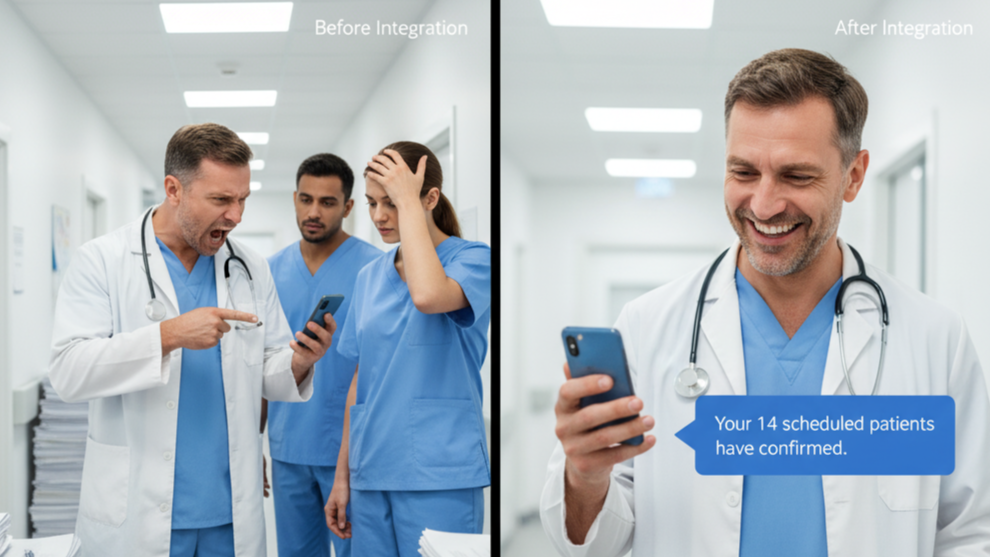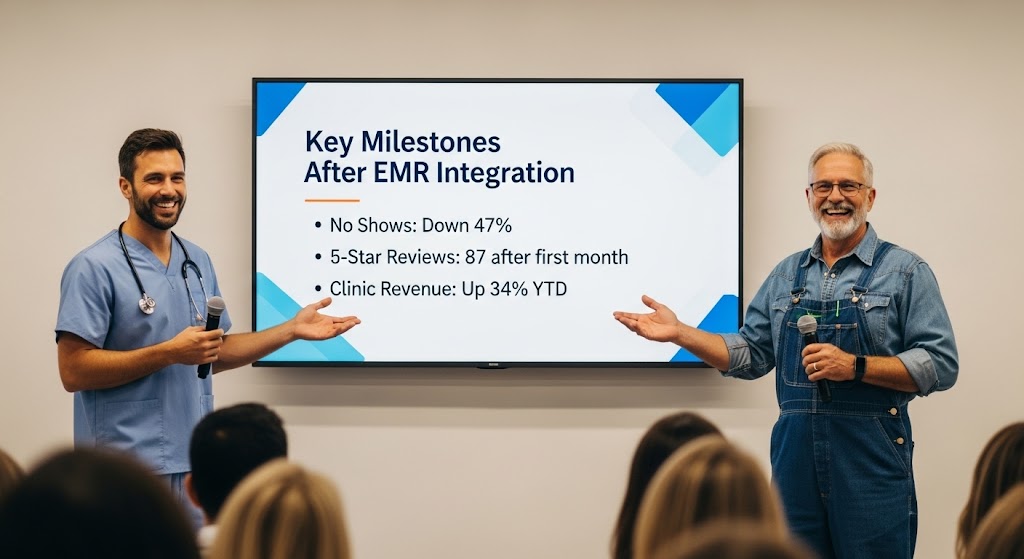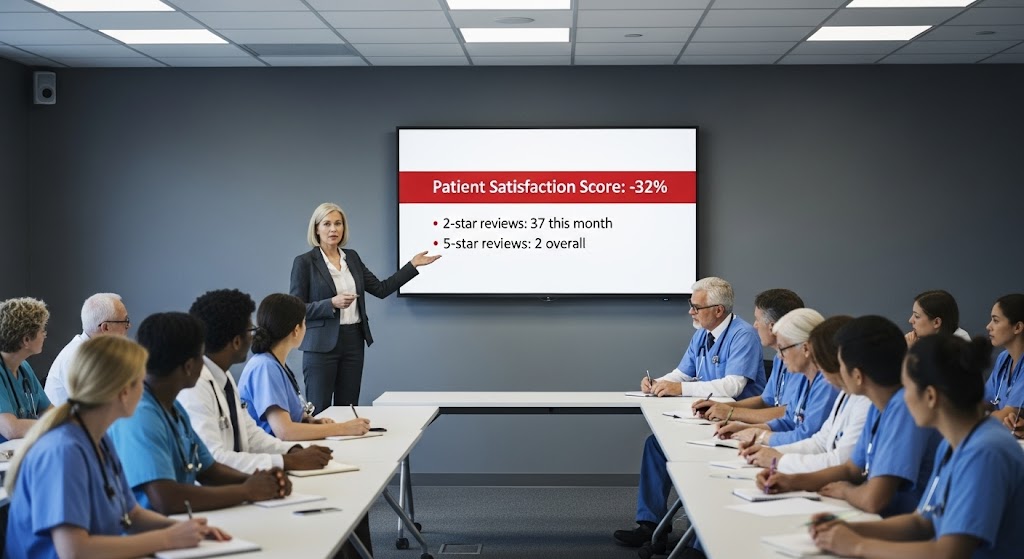EMR Integration Success Story: A Small Clinic’s Actual Experience
💡 A small clinic fixed its biggest workflow bottlenecks by integrating communication with its EMR. Before: Staff spent hours on phones, patients...
7 min read
Gregory Vic Dela Cruz : 8/28/25 3:00 PM

In modern medical practices, administrators often ask: “What difference does integration actually make?” The easiest way to see it is to compare two scenarios. The first scenario being before integration, and the second as after. The contrast is stark. On one side: phones ringing nonstop, patients waiting too long, forms lost in translation, and staff exhausted by midmorning.
This blog takes you inside a clinic’s daily reality and will show how clinic workflow integration flips the script by walking through typical touchpoints—check-in, reminders, communication, intake, and billing.
You can see how healthcare staff productivity and patient communication improvement go hand in hand when EMR workflow automation runs in the background. If your clinic feels stuck in survival mode, this article will make the opportunity clear: integration can change the entire rhythm of your clinic's workday.
To understand the value of integration, it helps to look closely at the daily grind of a typical clinic before any automation or connected systems are in place. The picture that emerges is one of overworked staff, frustrated patients, and administrators trying to patch problems with more effort instead of better systems. Here’s how a day unfolds before clinic workflow integration.
The day begins with a rush of phone calls. By 8:00 a.m., the front desk is already overloaded with patients calling to confirm appointments, ask about prep instructions, or reschedule because of conflicts. Staff attempt to keep up by leaving voicemails, but without integration, there’s no automatic update in the EMR. This often leads to double work: one staff member might be calling to confirm while another takes a message from the patient canceling the same slot. The phones don’t stop, and by midmorning, staff are already drained.
Patients arriving at the clinic add another layer of stress. New patients line up with paper forms in hand. Returning patients roll their eyes at being asked for the same information they gave last visit. Staff juggle clipboards, insurance cards, and IDs, re-entering the same details into multiple systems. Errors are common, and waiting times stretch longer. The tone for the day is set: frantic, reactive, and inefficient.
By midmorning, the cracks show up on the provider side. Despite full schedules on paper, several appointment slots are empty. Patients never confirmed because reminders were inconsistent or sent too late. Others simply forgot or got confused about instructions. One patient shows up at the wrong location; another cancels last minute because no fasting instructions were received. These no-shows cost the clinic hundreds of dollars in lost revenue per day, and providers feel their time is wasted. Administrators recognize the problem, but without EMR workflow automation, it repeats daily.
Throughout the day, patients continue to call with questions: “Do I need to bring labs?” “Where do I park?” “Am I supposed to stop medications before the scan?” Because the clinic’s communication tools are not integrated, answers aren’t always at staff’s fingertips. They dig through sticky notes, old voicemails, or printed prep sheets. Sometimes they give incomplete answers, promising to call back later after checking with providers. Patients sense the inconsistency, and confidence in the clinic drops. For staff, this constant chasing of information erodes productivity and morale.
The waiting room is clogged with clipboards and pens. Patients fill out intake forms by hand—sometimes multiple pages long—while balancing kids or rushing from work. Staff later re-enter this data into the EMR, creating more delays and increasing the chance of mistakes. Handwriting is misread, insurance IDs are copied incorrectly, and clinical details are sometimes skipped because staff are pressed for time. Billing teams downstream deal with denials that could have been prevented if intake had been accurate. The inefficiency doesn’t just hurt operations—it directly impacts revenue and patient experience.
By afternoon, the financial side begins to show its strain. Without integrated text-to-pay or digital workflows, patients either don’t pay balances at check-in or ignore mailed statements. Staff make collection calls, but these are time-consuming and rarely effective. Accounts receivable piles up, and administrators lose sleep over cash flow. The system is designed for friction, not speed.
As closing time approaches, the staff aren’t winding down—they’re scrambling. Voicemails are unchecked, appointment notes need updating, and billing tasks remain incomplete. The front desk is still fielding calls from patients who received mixed messages about their appointments. Staff leave late, drained from a day of reactive work. Burnout feels inevitable, especially when they know tomorrow will bring more of the same.
Providers feel the frustration too. They deal with empty slots, delayed starts, and patients arriving unprepared. Their time isn’t used efficiently, and they’re forced to repeat information that should have been handled through intake or reminders. The sense of wasted potential builds resentment, which can harm retention of both staff and providers.
Patients also notice the disarray. They wait on hold for long periods, get voicemails instead of answers, and are asked to fill out the same paperwork multiple times. Missed or inconsistent instructions lead to confusion, frustration, or worse—canceled procedures. In an age when consumers expect convenience in every other industry, healthcare’s lack of integration stands out. Patients may forgive one or two poor experiences, but over time, they look for clinics that communicate more clearly and respect their time.
The biggest casualty of life before integration is predictability. Administrators cannot rely on schedules being accurate, providers cannot rely on patients being prepared, and staff cannot rely on their workload being manageable. Instead, everyone runs harder just to keep up. This reactive cycle drains morale and bleeds revenue, making long-term growth unsustainable.
Life before clinic workflow integration is a constant uphill climb. Disconnected systems force staff into manual, repetitive tasks that waste time and money. Patients feel the impact as frustration and missed care. And administrators are left with a clinic that runs on effort instead of efficiency.
.png?width=908&height=613&name=EMR-integration-daily-workflow-mid%20(1).png)
Now, let’s replay the same day in a clinic where EMR workflow automation is in place. Every touchpoint feels different—not because staff work harder, but because systems do the heavy lifting.
At 8:00 a.m., the front desk opens to a steady but manageable flow. Phones are quieter because patients confirmed or rescheduled via automated reminders. Staff see confirmations update directly in the EMR. Instead of chasing calls, they greet patients and check schedules with confidence.
Reminders now follow a smart cadence—72 hours, 24 hours, 2 hours—delivered by text and synced to the EMR. Patients confirm with a tap. No-shows drop dramatically. Providers have fuller schedules, revenue stabilizes, and administrators see immediate improvement in resource utilization.
Patients with questions simply reply to their reminder text. Staff respond from a shared inbox, seeing appointment context alongside the conversation. Directions, prep instructions, and policy details are one click away. Patients feel guided, not lost, and satisfaction rises as confusion fades.
Before arrival, patients complete secure forms on their phone. IDs and insurance cards are uploaded in seconds. At check-in, staff review and approve submissions, pushing data directly into the EMR. The waiting room flows smoothly. Errors fall, check-in times are cut in half, and billing accuracy improves.
Instead of juggling calls, the front desk uses templates in the shared inbox to answer common questions instantly. Staff feel in control, not overwhelmed. Healthcare staff productivity climbs as routine tasks take minutes instead of hours. Burnout risk drops, and morale improves.
After visits, patients receive a text-to-pay link tied to their account. Co-pays are collected pre-visit, balances cleared post-visit. Administrators track payments in real time, reducing days in A/R and easing cash flow pressure. Staff no longer chase mailed statements or spend hours on billing calls.
At 5:00 p.m., the phones are quiet. The inbox is clear. Staff leave on time. Providers finish the day with full schedules and fewer interruptions. Administrators review metrics—attendance, confirmations, payment collections—and see steady upward trends. The office feels calmer, more predictable, and more sustainable.
This “after” scenario isn’t hypothetical. It’s what happens when clinic workflow integration takes root. By linking reminders, messaging, intake, and billing into the EMR, tasks run themselves. The shift is cultural as well as operational. Staff gain time and confidence, patients feel supported, and providers operate at full capacity.
The lesson is simple: healthcare staff productivity, patient communication improvement, and EMR workflow automation aren’t abstract benefits. They’re daily realities you can measure in minutes saved, calls avoided, patients satisfied, and revenue protected.
Curogram brings integration to life by layering smart communication and automation on top of your existing EMR. The goal isn’t to replace your system, but to make it work harder for you. Here’s how each feature powers the daily improvements we just described.
Automated reminders are tied directly to the EMR schedule. Messages are always accurate, with visit-specific details and prep instructions. Patients confirm, cancel, or reschedule in seconds. Clinics see no-shows fall by up to 75 percent.
Patients text questions, staff reply in a shared HIPAA-compliant inbox. Templates make responses quick and consistent. This cuts phone traffic nearly in half, freeing staff to focus on patients in front of them.
Online forms replace clipboards. Patients submit demographics, consents, and insurance before arrival. Staff validate and sync data directly into the EMR. Check-in times drop, errors fall, and claims move faster.
Payment links embedded in reminders and follow-ups drive faster collections. Clinics collect more balances within days instead of weeks. Cash flow strengthens, and staff spend less time chasing unpaid accounts.
Post-visit micro-surveys prompt reviews and flag issues for recovery. Clinics gather more five-star ratings and resolve complaints quickly. Reputation improves, drawing in more patients over time.
Together, these tools deliver the transformation that administrators want. As a result, your practice will experience calmer mornings, predictable schedules, happier staff, and engaged patients. The “before” day fades, replaced by a workflow that feels sustainable and productive.
The gap between before and after integration is measured in stress, time, and revenue. Without integration, every task feels heavier than it should. With integration, staff focus on people, not paperwork; patients arrive informed and prepared; and administrators finally see predictability in the metrics that matter most.
Curogram makes this shift achievable in weeks, not months. With HIPAA-compliant reminders, texting, intake, payments, and surveys layered on your EMR, your clinic can go from survival mode to sustainable mode. The result is higher productivity, stronger patient communication, and a calmer daily rhythm.
Ready to see your own before-and-after transformation? Schedule a demo today and get a tailored plan to bring integration into your clinic workflow.

💡 A small clinic fixed its biggest workflow bottlenecks by integrating communication with its EMR. Before: Staff spent hours on phones, patients...
.png)
💡Not every process needs integration on day one. The key is knowing where to begin. By identifying the most painful parts of your...

💡EMR integration improves patient experience by eliminating data silos and delays across scheduling, intake, visits, and follow-up. With a...